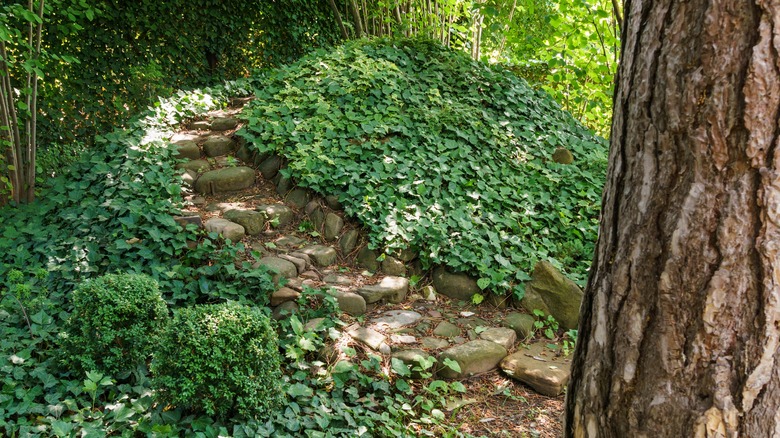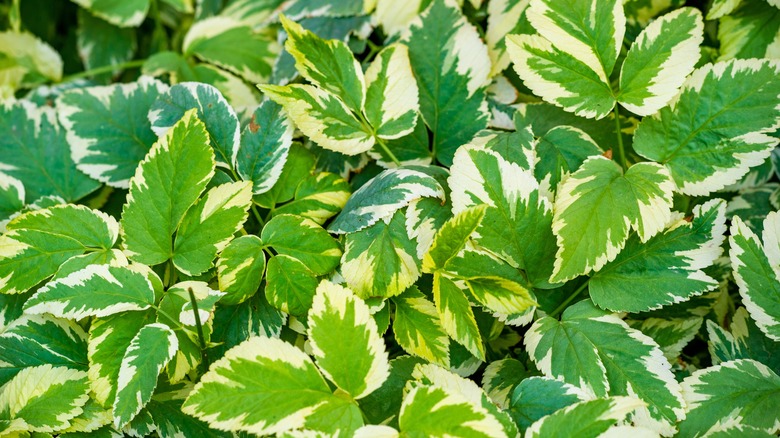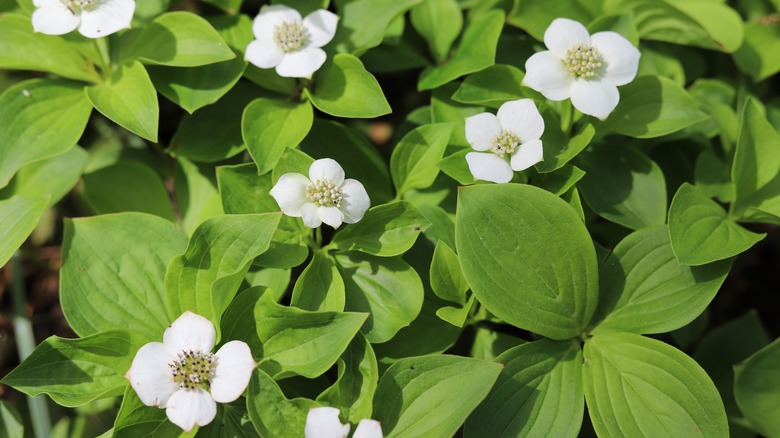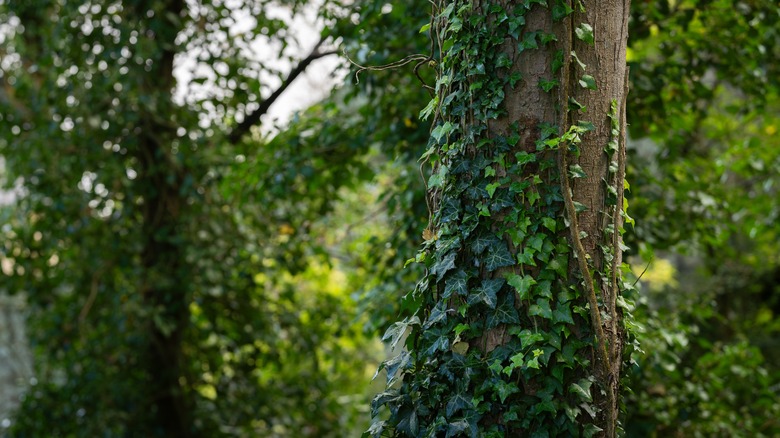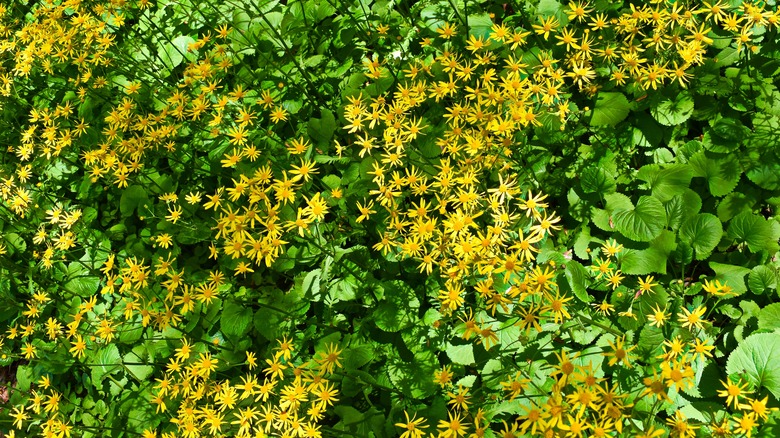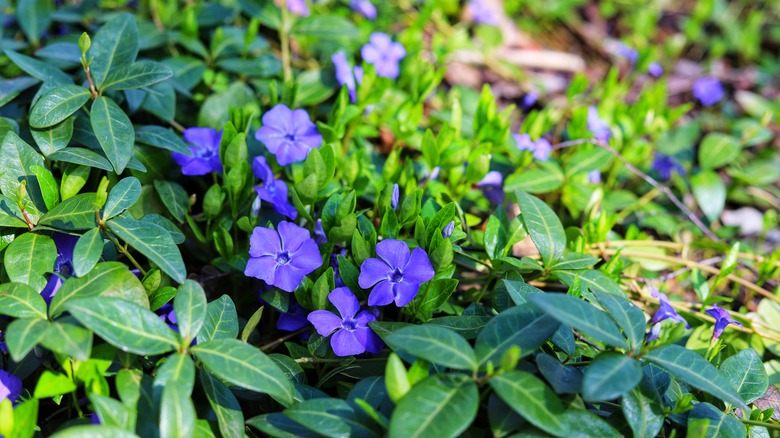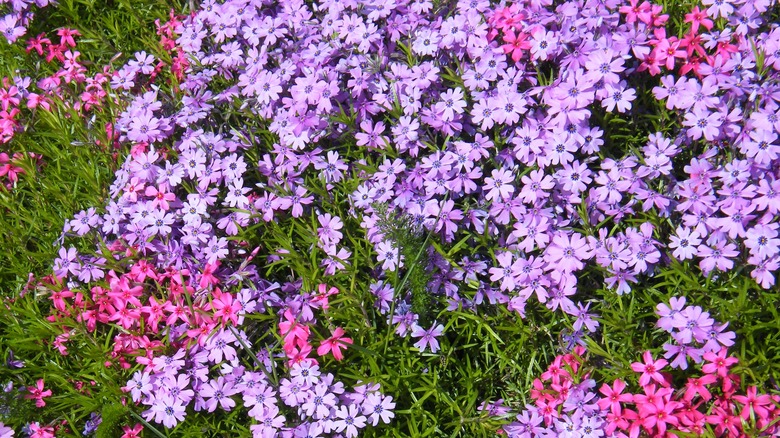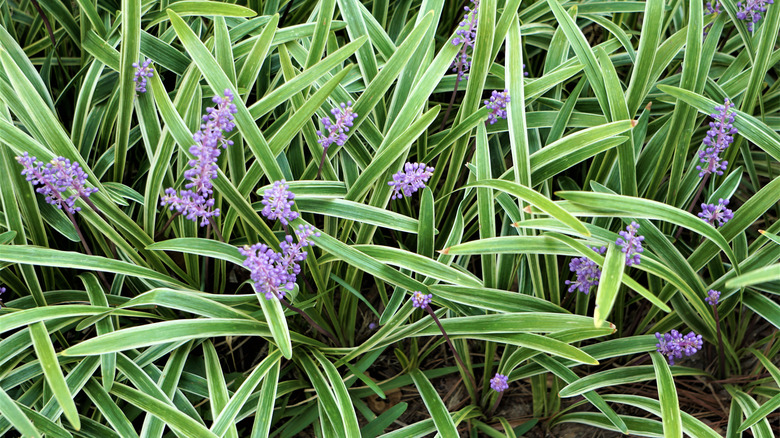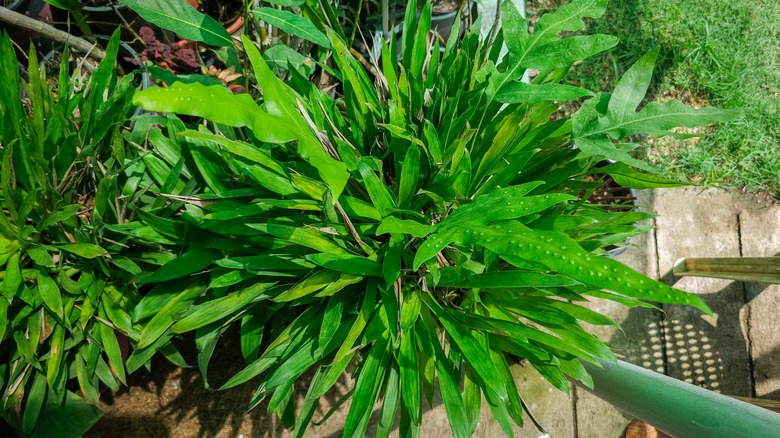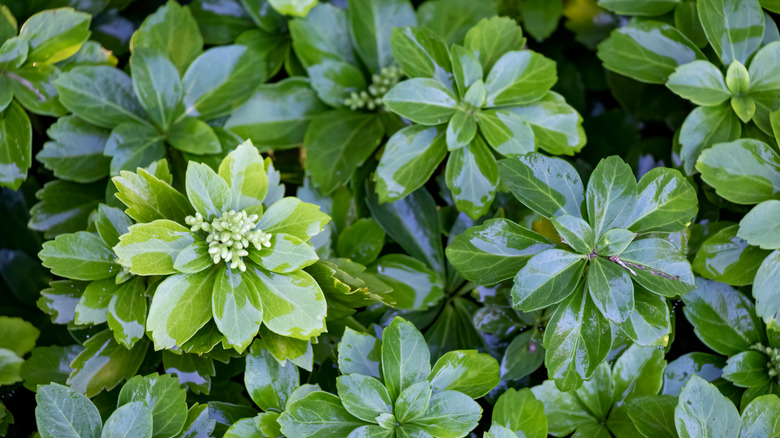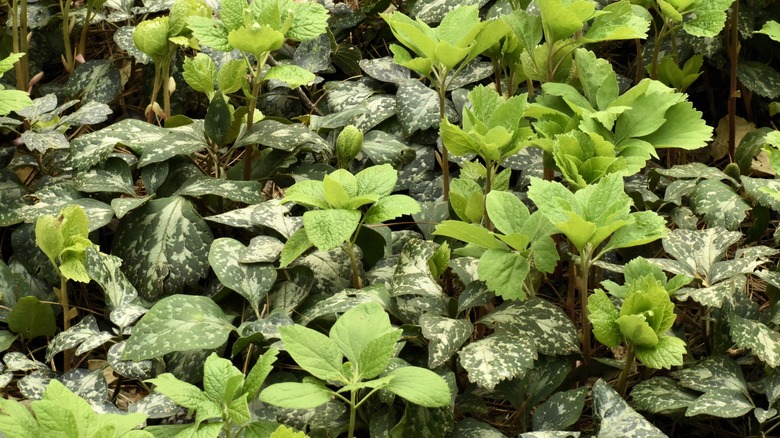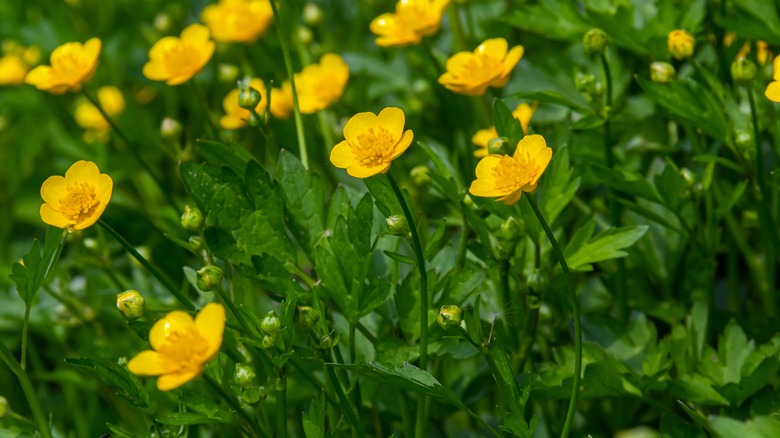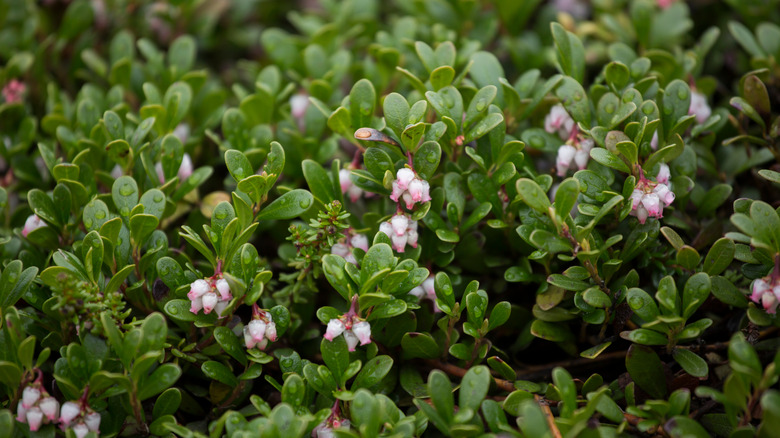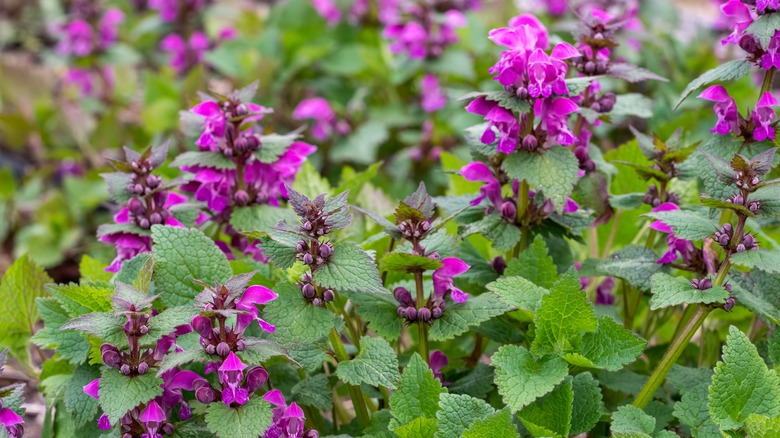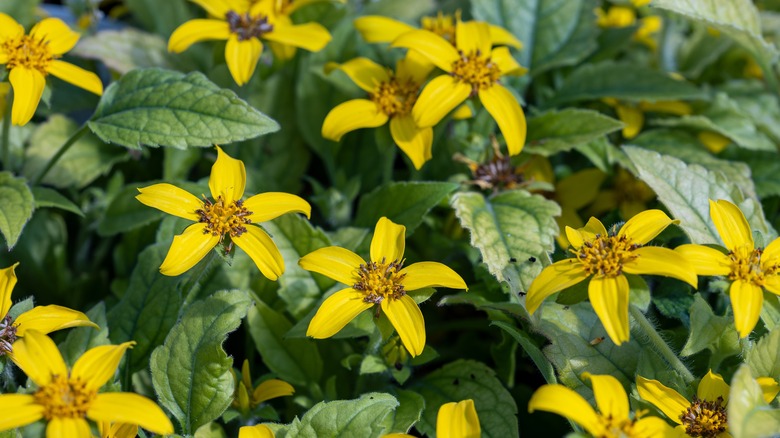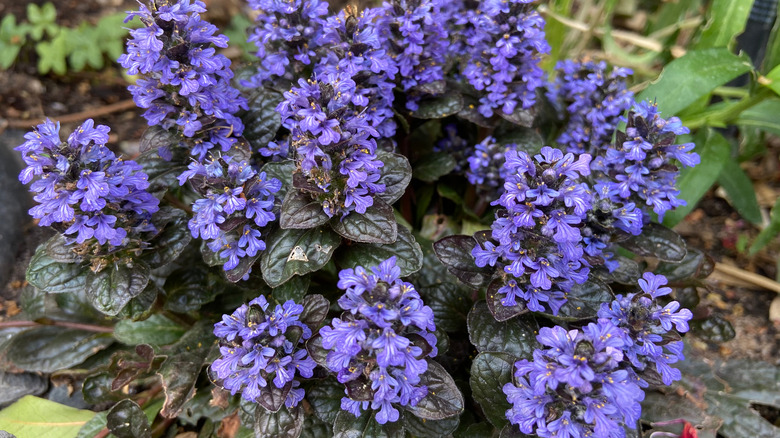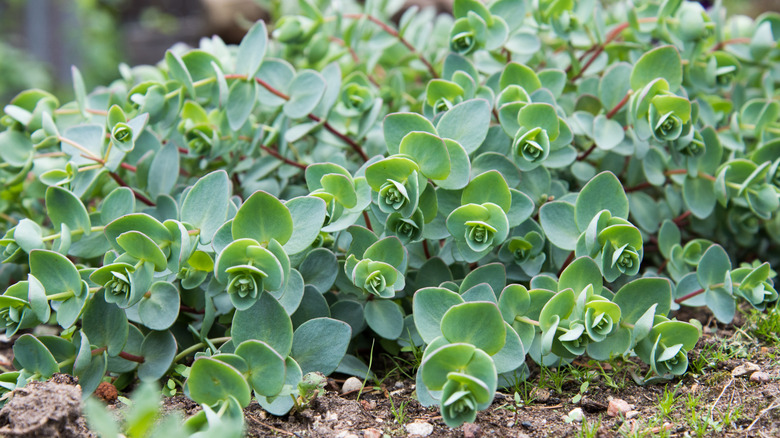Fast-Spreading Invasive Ground Covers To Steer Clear Of (& What To Plant Instead)
Ground covers have many benefits; however, when these plants become invasive, they also present drawbacks. Tipping the scales in favor of ground covers: they add life and color to the yard while requiring little maintenance. They also protect the soil and help retain moisture. At best, they can coexist with other plants while suppressing weeds. Many ground covers even grow in shaded areas where grass and other plants can't thrive. So, what's not to love about them? By their nature, these plants are made to spread. However, it's that very quality that can make them so invasive.
Ground covers, particularly non-native varieties, can quickly take over your garden. Not only that, they commonly escape cultivation, taking root in natural areas. There, invasives jeopardize biodiversity by outcompeting native plants. Indeed, the U.S. Forest Service estimates that invasive plants are responsible for the decline of 42% of endangered and threatened species; they are the leading cause of the decline of 18% of endangered and threatened species. However, when selecting a ground cover, it's possible to reap the benefits they provide without entirely giving your yard over. To do this, swap invasive ground covers for native plants that pose less risk to your yard and surrounding landscape. Native plants can be purchased at most landscaping centers. In some localities, you can even find garden centers that specialize exclusively in native plants. Ideally, buy plants that haven't been sprayed with pesticides, as many of these ground covers are pollinator magnets.
Don't plant goutweed
Goutweed, or bishop's weed, is a historic treatment for medical ailments such as gout and is considered invasive throughout the United States. A member of the carrot family, its tiny white flowers resemble those of the vegetable, and it exists in either variegated or non-variegated forms. Like most ground cover, goutweed thrives in shaded areas. A perennial native to Europe, the plant was brought to North America by colonizers, where it reproduced vigorously — and not just in residential gardens. Goutweed spreads underground through rhizomes, which are effectively underground stems. The rhizomes send out runners and roots, allowing plants to spread laterally without self-seeding; this process allows goutweed to outcompete other plants in a garden bed.
If your garden has goutweed, you may already be familiar with the process of keeping it from spreading. (You may also know just how difficult it is to remove entirely.) Pulling goutweed by hand will remove the leaves and stems but will leave the rhizome, so you should use hand tools to dig the whole system up. Unfortunately, even after doing this, some pieces of rhizome may be left behind, and any remaining plant matter can be re-rooted and result in new growth. Therefore, repeated removals will be necessary to eliminate this invasive plant. To help prevent it from regrowing, always dispose of goutweed in bagged trash; never compost it, as the old plant matter can re-root and spread to other areas.
Do plant bunchberry
Like goutweed, bunchberry (or bunchberry dogwood) is a shade-loving, perennial ground cover that gives forth lovely white flowers. However, it has other benefits that goutweed lacks. Foremost among these virtues? Bunchberry is not invasive and poses no risk to natural areas. This makes it an excellent choice for any residential garden, particularly those situated near woodlands, streams, parks, or other wild areas. This plant is native to the Pacific Northwest. As such, it will do well in conditions that resemble those of its natural range. Plant bunchberry in parts of your yard that mimic the woodland habitats from which it hails. Positioning bunchberry under trees or shrubs helps guard the plant from the sun's scorching rays while allowing it to retain moisture.
Bunchberry prefers cool, moist, and acidic soil. It does best in USDA growing zones 2 to 7. You can choose to plant it from starter plants, available at nurseries, seed, or cuttings. When growing bunchberry from seed, sow in the fall and allow a period of overwintering. Then, in the spring, it will reward you with white flowers that attract pollinators. Blooms give way to red berries that birds will eat during the summer.
Don't plant ivy
English ivy's presence in North America predates the establishment of the United States. Indeed, it's been in the region since at least 1727, when it was brought here by colonists. The plant is extremely invasive and has had plenty of opportunities to invade natural areas for over 300 years. Ivy is listed as an invasive plant in both the eastern and western United States. In regions where it has invaded natural areas, especially woodlands, ivy chokes out native plants. As native plant populations decline, so do the animals who depend on those plants.
Despite its invasive qualities, ivy has enjoyed popularity as a landscaping plant thanks to its low maintenance, ability to thrive in shaded areas, and evergreen color. It's not entirely maintenance-free, though. As quickly as ivy spreads, it needs to be cut back. It will climb trees, fences, and houses if allowed to spread. Although it can look charming when covering a house, it's a mistake to leave it there. Removing ivy from your yard altogether can require hours of hand-pulling. However, removal is usually successful, straightforward, and doesn't require multiple interventions. Tender roots, typical of newer growth, can simply be pulled. Woody roots can be cut with loppers to dry out the vines. Then, the remaining plant can be dug up. Take care, though. Ivy contains irritants, falcarinol and didehydrofalcarinol, both of which can cause rashes. For this reason, and to protect against blisters, wear gloves when removing ivy.
Do plant golden ragwort
If ivy's main virtue is providing evergreen color in shaded areas, and with little maintenance, there are many native plants that can do the same and more. Any native shade-loving evergreen ground cover can be an effective stand-in for ivy. One of the most versatile of these is golden ragwort. Native to the eastern and midwestern United States and Canada, golden ragwort can thrive in shade, part shade, and even full sun. (For a west-coast-friendly alternative, consider alumroot instead.) Ragwort's leaves are evergreen, and the plant bursts with yellow spring flowers in April and May. In its native range, golden ragwort will often be found along streambeds and wetlands. As a moisture-loving plant, it's suitable for rain gardens or along a waterlogged border of a pond. In terms of maintenance, golden ragwort is relatively easy. Snip the flower stalks back after they've gone to seed to clean up the garden bed. This can even be done with a string trimmer to expedite the process and get hard-to-reach areas.
Golden ragwort is a good option for gardeners due to its low maintenance and ability to grow in shade. However, it's also beneficial for wildlife. This plant feeds pollinators, including bees and butterflies. It's even the host plant of the metalmark butterfly. During the summer months, lightning bugs can be found among the foliage, as it provides excellent cover for them. The dried seedheads lure songbirds, who feast on the seeds. Even better, the plants are both rabbit- and deer-resistant.
Don't plant vinca minor
Like ivy, vinca minor (or periwinkle) has been beloved by gardeners for its evergreen cover, low maintenance, and shade tolerance. Unlike ivy, this plant blooms with charming purple flowers. However, don't let its innocent blossoms deceive you. The flowers may look sweet, but they offer little sustenance for pollinators. Indeed, vinca minor is not a compelling food source for mammals either. Nature-loving gardeners would do better to choose a native ground cover instead.
In many states, conservation departments warn against planting vinca minor. That's because it's invasive and can outcompete native plants when it creeps into natural areas. Becoming an unwitting participant in that process is a risk you take by growing this plant, as it does often escape cultivation. For that reason, it's important to avoid planting vinca minor if you live near woodlands, streams, or other shaded areas where conditions are right for it to run wild. Should you need to vanquish this invasive vine from your garden, it can be removed by hand-pulling. Digging is not typically required for removal, but loosening the area with a hand rake can make the process easier.
Do plant creeping phlox
If you're seeking a less invasive replacement for vinca minor, creeping phlox certainly checks a lot of boxes. Also called moss phlox, some varieties are shade tolerant, while others prefer sun. The perennial plant's leaves are semi-evergreen to evergreen. Plus, it brings forth small blue, purple, pink, or white flowers, which are even more attractive than vinca's blooms. Unlike vinca minor, creeping phlox attracts pollinators, including hummingbirds and butterflies. Furthermore, it can withstand dry conditions and is fairly disease- and pest-resistant. Even deer will typically steer clear of this plant.
Creeping phlox comes in many varieties. Each one may differ in terms of where they thrive and also in their care requirements. Look up the varieties before you buy to make sure you choose the best one for your yard. When planting phlox, bear in mind that the plant has a creeping habit, but it is not a vining plant. This means it won't spread far beyond the bounds of where you place it. It also means you'd do well to add multiple plants if you want to fill a large area. This plant is a good option for rock gardens, borders, and other areas. To successfully grow creeping phlox, it's typically best to plant it in a sunny area, but check your cultivar first.
Don't plant liriope
Liriope, known as monkey grass or lilyturf, was once prized in gardens for its evergreen quality. Its flower spikes and fall berries also made it an interesting choice for growers. While you can still buy this plant in garden centers, several states warn against planting it. The precautions of conservation departments are well-founded. Indeed, liriope has been found in natural areas, particularly in the southeastern and midwestern United States. There, it encroaches onto the turf of native plants, even to the point of eliminating them from an area. If and when this happens, the negative impact on other creatures within the habitat cannot be overstated; they can be deprived of food and host plants.
A member of the asparagus family, liriope spreads into other areas (whether in your yard or in the wild) through its rhizomes. Although the plant is touted as low maintenance, in reality, its tendency to spread means that weeding is a way of life for those who grow it. If you already have liriope in the garden, it's possible to remove it. The dense clumps can be difficult to remove by hand pulling, though. Instead, this is a job that may require digging to uproot the plant. If needed, this process can be repeated to remove the entire plant.
Do plant seersucker sedge
Instead of opting for liriope, try this native perennial instead. Seersucker sedge, also called crinkle leaf sedge, grows in semi-evergreen clumps that reach 6 to 12 inches high. In early spring, interesting flower stalks appear. These last until early summer. For those who favor the typical blooms found at garden centers, the seersucker sedge's flowers may look unfamiliar. However, these flowers are no stranger to pollinators. Insects use the flowers for pollen, and foliage plays host to satyr butterfly larvae.
Seersucker sedge has a native range that spans the eastern part of North America, from Alabama and South Carolina into Ontario, Quebec, and Nova Scotia. This sprawling range means it's very forgiving with regard to temperatures and thrives in zones 3 to 8. Remember that seersucker sedge is a woodland plant by nature. Since it grows under canopies in the wild, it prefers similar conditions in cultivated areas. Plant this sedge in shade to part shade for best success. Once established, you can practically leave it alone for most of the year. Flower stalks will fall away on their own, eliminating the need for deadheading. However, the most important maintenance task you should always do is an annual pruning. The plant should be shorn to about one inch above the ground in mid-February before new growth emerges. Don't leave the task for too late in the season, as this will clip flowers before they can spring forth.
Don't plant pachysandra
Still, it's not hard to understand how Japanese pachysandra, or Japanese spurge, became popular stateside. It's perennial, evergreen, hardy, low-maintenance, and it tolerates shade. However, now that its invasive qualities are more widely known, it's hard to justify growing it in today's gardens. That's because this member of the boxwood family easily grows beyond the bounds of where it's planted. This is not only true in your own garden; it often escapes cultivation and encroaches onto natural areas. There, it can overrun native plants and reduce biodiversity. Pachysandra is considered particularly invasive in the northeastern United States and near the Great Lakes. So, take particular care if you live in one of those regions.
Like many invasive plants on this list, pachysandra spreads through rhizomes. The dense foliage that gardeners have trusted to block out weeds also chokes out native plants when pachysandra finds its way into the wild. Removing pachysandra can usually be done by hand. You can hand pull if you're simply limiting the spread from around a garden bed. If you intend to eliminate an entire patch of pachysandra, dig out as much of the rhizome as possible to prevent regrowth. To tackle extensive areas, a controlled application of herbicide may be indicated.
Do plant Allegheny spurge
Allegheny spurge is a pachysandra, too: Pachysandra procumbens. Unlike its Japanese counterpart, however, Allegheny spurge has a native range in the southeastern United States. This means it is a familiar part of the ecological webs in this part of the world. Like all native plants on this list, it enjoys beneficial relationships with animals and plants that exist in this region. In spring, it sends up spikes of fragrant white flowers, which attract pollen- and nectar-loving bees and birds.
Allegheny spurge is fairly versatile and can be grown in a range of zones. It is deciduous in colder zones (5 to 6) but remains semi-evergreen in warmer climes (zones 7 to 9). This perennial is an excellent plant for low-maintenance gardeners because it's hardy, drought-tolerant, and disease- and deer-resistant. (Although it is generally pest-resistant, it may be visited by slugs, mites, or blight.) The most harmful thing you can do to an Allegheny spurge is to plant it in full sun. Otherwise, the plant is quite forgiving. The foliage is similar in shape to that of invasive Pachysandra, and the flowers are similar in appearance. So, if you like Pachysandra for its look but don't like its invasive tendencies, Allegheny spurge is a no-brainer swap.
Don't plant creeping buttercup
Creeping buttercup is invasive in most of the United States and Canada, particularly in the Pacific Northwest. It grows wild in moist soils and thrives in sunny or shaded areas. Although this perennial is rarely cultivated and is considered a weed, it finds its way into residential lawns and gardens. Because of its charming yellow flowers, which bloom in May and June, some homeowners may be tempted to keep it or transplant it to other areas of the yard. This should be avoided. Creeping buttercup spreads by stolons, which are above-ground stems that creep along the ground and form new roots, and it spreads fast. In fact, a single plant can overtake other plants to form a monoculture.
When not in bloom, creeping buttercup is identifiable by its leaves. However, these leaves can take multiple forms. At times, you may find creeping buttercup plants with leaves comprised of three leaflets. At other times, plants may present with three-lobed leaves. That said, creeping buttercup is often mistaken for native buttercup. So, if you're unsure about which plant you have, consult your local extension office or a trusted website specializing in identifying invasive plants before removing the plant from your yard. The recommended treatment for creeping buttercup is to increase the density of your lawn. This can typically be done by fertilizing it. Alternatively, frequent mowing can reduce the flowers' spread. Lastly, postemergence herbicides can be used to spot-treat the plant.
Do plant kinnikinnick
Kinnikinnick, also called bearberry, makes an excellent and easy-care ground cover or pollinator gardens. The evergreen perennial has clusters of white and pink flowers from March to June. These will attract pollinators to your yard and garden, including hummingbirds, butterflies, bees, and other insects. (Plus, it's also the host plant of the Hoary Elfin butterfly.) Flowers give way to small red fruits that can remain from July through late winter and feed wildlife. It's also an excellent choice for gardeners in the Pacific Northwest, as that's where the plant hails from. As such, it grows best in that area or in climates that resemble it. It's even recommended by the Washington State Noxious Weed Control Board as an ideal ground cover for that area.
Choose kinnikinnick, particularly for rocky gardens, acidic soils, or slopes. Be mindful of your zone. Kinnikinnick can tolerate winter temperatures of 30 degrees Fahrenheit. In zones that get much colder, this plant may grow as an annual. If cold isn't too much of an issue in your area, this plant can withstand various other conditions. It's deer-resistant and grows well in partial shade to full sun. It's mostly drought-tolerant, too, but if grown in very sunny areas, it may require more frequent watering in order to thrive. Kinnikinnick can be grown from start plants, which are often available at landscaping centers. Alternatively, the plant can be propagated from cuttings. Do this in spring for best results.
Don't plant deadnettle
Deadnettle is perennial, drought-tolerant, shade-tolerant, and attracts pollinators. It's even edible for humans. So, what's not to love? The answer: this member of the mint family is very invasive in the United States. Native to Europe and western Asia, gardeners have often cultivated deadnettle intentionally as a ground cover. Beloved for its purple flowers and low maintenance, deadnettle can easily escape cultivation and spread across lawns and into natural areas. This is partly due to the fact that it can spread both by runners and by seed. Once loose, it can overtake native plants and threaten ecosystems. For this reason, it's important to avoid deadnettle in order to protect local biodiversity.
Avoid planting deadnettle as a ground cover. If you already have deadnettle in your lawn, it can be removed by hand-pulling. It can also be spot-treated with either pre-emergence or post-emergence herbicide. The type you use will depend on the type of turf grass in which the deadnettle grows. If your lawn is comprised of either Bermuda or zoysia grasses, choose a post-emergence herbicide. For all other turf grasses, pre-emergence herbicide can be used instead.
Do plant goldenstar
Goldenstar, also known as green-and-gold, is a semi-evergreen, flowering perennial. Native to the eastern United States, this low-growing ground cover is not invasive. It will provide beautiful interest to gardens without completely overtaking other plantings. In the wild, it is found in woodland habitats. Not surprisingly, in cultivation, it favors light conditions that mimic its natural habitat. That means shade, part-shade, or dappled shade. The plant is accessible for gardeners across the north and south, as it is hardy in zones 4 to 10. Plus, it's a showstopper. It gives forth bright, star-shaped, yellow flowers from spring to fall. These give way to berries that feed birds.
Goldenstar can be planted from starter plants available at landscaping centers. Space these several inches apart. In time, the plants will spread through stolons and seeds to fill the area. Alternatively, you can grow goldenstar through propagation. To propagate, take a cutting of the stolon and root in spring. Then, transplant this to another area of your garden. You can also divide large plants in late spring. Look for a good dividing point in the crown of the plant. Dig into the soil at this point, separate, and plant the divided part. One word of warning to would-be gardeners of this plant: Goldenstar can fall victim to downy mildew. Reduce plant crowding to reduce the risk. Consider drip irrigation rather than watering methods that leave water on the leaves.
Don't plant ajuga
Ajuga, also known as carpet bugle or bugleweed, is beloved by many gardeners of shaded plots. The plant spreads quickly through runners and can cover a bed in low-maintenance foliage and spikes of purple flowers. Ajuga leaves range from light green to blackish green. Despite its virtues in a garden setting, this semievergreen plant is invasive in some parts of the United States. When it escapes cultivation, it can wreak havoc on natural areas, particularly woodlands and meadows. Growing ajuga requires vigilance and care to keep it from spreading. A safer course would be to avoid planting ajuga altogether.
Frequently grown in shade or part-shade, ajuga tolerates sun too. It grows slower than some invasive plants on this list, which may contribute to the fact that some extension services still recommend ajuga for shade gardens. However, even in a garden setting, ajuga can spill over its intended borders and creep into lawns. Ajuga has been found to be invasive in natural areas in the Midwest, southeast, northeast, and the Pacific Northwest. It is officially listed as invasive according to the governments of Oregon, West Virginia, and Maryland. Avoid this plant, particularly if you live in these regions.
Do plant Oregon stonecrop
Like ajuga, Oregon stonecrop can thrive in part shade. Unlike ajuga, however, this plant is noninvasive. The evergreen ground cover is native to the Pacific Northwest. The succulent foliage can range from green to red, depending on the light conditions. Adding even more color when yellow flowers burst forth in summer. These attract pollinators, while the plant itself plays host to some caterpillars. If that weren't enough, the plant is also edible to humans. Oregon stonecrop has long been harvested by Native American tribes like the Haida and Nuxalk people and used as both food and medicine. For ecological reasons, foraging plants in the wild can be tricky. However, this sedum can be easily harvested when grown in your garden. In moderation, it can be eaten raw in salads or cooked. Many types of sedum exist, but not all of them are what you'd want to eat. So, when planting Oregon stonecrop, double-check the name on your packaging to make sure you chose the correct one.
Oregon stonecrop spreads via rhizomes and has a cascading habit. This shape makes it ideal for growing along retaining walls or within rock gardens, both of which mimic its natural environment of rocky outcroppings. Stonecrop will spread laterally over time. It's best to plant the starter plants every several inches and allow them to fill in the gaps over time. The plant's rhizomes can be divided in spring or early summer and transplanted to new areas.
